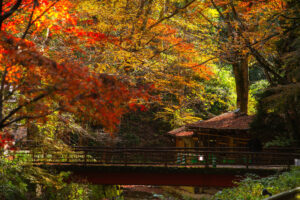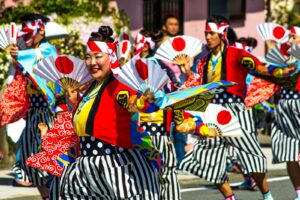In the heart of summer, when the air is thick with the warmth of the season, Japan enters a period of profound spiritual significance. The Obon Festival, a centuries-old tradition, transforms the country into a vibrant tapestry of light, dance, and heartfelt memories. This festival, deeply rooted in Buddhist beliefs, is a time when the veil between the living and the dead is believed to thin, allowing ancestral spirits to return home. From the bustling streets of Tokyo to the serene countryside, Obon is a nationwide embrace of the past, a celebration of the cyclical nature of life, and a dazzling display of cultural richness. Join us as we explore the multifaceted dimensions of the Obon Festival, from its ancient origins to its contemporary celebrations, and discover why this event remains one of Japan’s most cherished occasions.
Obon Festival: A Gateway to the Spirit World
The Obon Festival, observed from the 13th to the 15th of August, is more than a mere cultural event; it is a spiritual passage that connects the living with the souls of their ancestors. This period is marked by a series of rituals and customs designed to honor the deceased, guiding their spirits back to the family home, and ensuring their peaceful return to the spirit world. The festival’s significance is deeply intertwined with the belief in the continuity of life, a belief that underscores the importance of maintaining strong bonds with those who have passed. It is a time for reflection, remembrance, and reconnection with the roots from which families have grown.
The Origins of Japan’s Ancestral Tribute
The roots of the Obon Festival trace back more than 500 years, drawing inspiration from the Buddhist story of Mokuren (Maudgalyayana), who, through his supernatural powers, saw that his deceased mother had fallen into the Realm of Hungry Ghosts. Deeply distressed, Mokuren sought the Buddha’s advice and was instructed to make offerings to the monks returning from their summer retreat on the fifteenth day of the seventh month. Through these acts, Mokuren’s mother was liberated, leading to the inception of a festival celebrating the relief of ancestors’ suffering. This tale underscores the festival’s dual focus on familial piety and the liberation of souls.
Obon Today: Tradition Meets Modernity
While the essence of Obon remains rooted in tradition, contemporary celebrations have evolved, embracing modern elements without losing sight of their profound spiritual meaning. Today’s Obon festivals are characterized by an assortment of events that cater to both the young and the old, from traditional Bon Odori dances to vibrant fireworks displays and modern pop concerts. Technology, too, has found its place within the festival, with digital lanterns and virtual reality experiences allowing for new forms of ancestral homage. Despite these modern adaptations, the core purpose of Obon – to honor and remember the ancestors – remains unchanged, bridging past and present in a timeless celebration of life and death.
The Lanterns of Obon: Lighting the Way Home
Lanterns play a crucial role in the Obon Festival, serving as guides for the spirits to find their way back to their earthly homes. These lanterns, often inscribed with the names of deceased loved ones, are set afloat on rivers, lakes, and seas in a breathtaking spectacle known as Toro Nagashi. As the sun sets, the waterways of Japan become illuminated with these floating lights, creating a serene path for the spirits’ journey. This symbolic act is a poignant reminder of the transient nature of life, a beautiful send-off for the spirits as they return to the otherworld, and a visual spectacle that unites communities in remembrance and respect.
Bon Odori: The Dance that Welcomes Souls
Central to the Obon Festival is the Bon Odori, a folk dance performed to welcome the spirits of the ancestors. This dance varies significantly from region to region, reflecting the diverse cultural tapestry of Japan. Dancers, often dressed in traditional yukata, gather in parks, temples, and public squares, moving in unison to the beats of taiko drums. The dance is both a gesture of welcome and an offering of comfort to the visiting spirits, embodying the joy and sorrow of reunion and parting. It is a powerful expression of community and continuity, a living tradition that keeps the connection between the past and present alive.
The Culinary Journey of Obon Festival
Obon is also a time of culinary significance, with special foods prepared and offered to both the living and the spirits. These offerings, known as "Shojin Ryori," are typically vegetarian, adhering to Buddhist principles, and include dishes such as "ohagi" (sweet rice balls) and "somen" (cold noodles). These meals are set out with care in front of family altars, inviting the ancestors to partake in the flavors of their earthly home. The act of preparing and sharing these foods reinforces the bonds of family and community, turning Obon into not just a spiritual journey, but a gastronomic one as well, celebrating the bounty of the earth and the culinary traditions of Japan.
Kyoto’s Spectacular Floating Lanterns Event
In Kyoto, the Obon Festival reaches its zenith with the Toro Nagashi ceremony, where thousands of lanterns are released on the city’s rivers. This visually stunning event draws crowds from all over the country and the world, spotlighting the ancient capital’s enduring connection to Japan’s cultural heritage. The reflection of the lanterns on the water, against the backdrop of Kyoto’s historic temples and shrines, creates a mesmerizing tableau that captures the essence of Obon: a moment of sublime beauty and poignant reflection on the cycle of life and death.
The Role of Buddhism in Obon Celebrations
Buddhism plays a central role in the Obon Festival, with temples across Japan hosting ceremonies and prayers for the deceased. These rituals, imbued with centuries of religious tradition, offer a pathway for the living to express their grief, gratitude, and wishes for the peace of their ancestors’ spirits. The chanting of sutras, the ringing of temple bells, and the offering of incense create a spiritual ambiance that is both solemn and uplifting. Buddhism’s teachings on impermanence and the interconnectedness of all life resonate deeply during Obon, providing a philosophical foundation for the festival’s observances.
Preparing for Obon: A Family Affair
The preparations for Obon begin long before the festival’s start, with families coming together to clean gravesites, prepare special foods, and decorate altars. These activities are not just tasks but meaningful rituals that strengthen family ties and honor the memories of the departed. Children learn about their ancestors, stories are shared, and the continuity of family history is preserved. This collective effort bridges generations, reinforcing the importance of family and community in the face of life’s impermanence.
The Impact of Obon on Japanese Culture
The Obon Festival has left an indelible mark on Japanese culture, influencing art, music, dance, and literature. It is a source of inspiration for creators, reflecting the depth of Japan’s spiritual landscape and the human emotions that accompany the cycle of life and death. Obon encapsulates themes of reunion and separation, joy and sorrow, creating a rich tapestry of cultural expression that resonates with people across the globe. It is a testament to the enduring power of tradition to convey universal truths and connect us to our shared humanity.
Obon Across the Globe: A Festival Without Borders
As Japanese culture has spread worldwide, so too has the celebration of Obon, transcending geographical and cultural boundaries. In countries with significant Japanese diaspora communities, Obon festivals have taken root, adapted to their new environments while retaining their core elements. These global celebrations are a testament to the festival’s universal themes of remembrance, family, and the cycle of life, fostering cultural exchange and understanding, and creating a global community united in the spirit of Obon.
Saying Goodbye: The Closing Ceremonies of Obon
The Obon Festival concludes with a series of closing ceremonies that bid farewell to the ancestral spirits, signaling their return to the spirit world. These rituals, often accompanied by more lantern releases or the extinguishing of lanterns, are a final gesture of love and respect. As the last lights flicker out, participants are left with a renewed sense of connection to their ancestors and a deep appreciation for the fleeting nature of life. The closing of Obon is both an end and a beginning, a moment of closure that opens the heart to the rhythms of the natural world and the cycles of existence.
The Obon Festival stands as a profound observance of life’s transience and the enduring bonds that connect the living to the dead. Through its rituals, dances, and communal gatherings, Obon encapsulates the essence of Japanese cultural and spiritual life, inviting reflection on the ties that bind humanity across time and space. As it continues to evolve, embracing both tradition and modernity, Obon remains a vibrant testament to the power of memory, the importance of family, and the universal quest for meaning in the face of mortality. In the dance of lights, the sway of the Bon Odori, and the solemn prayers, the spirits of the ancestors and the hearts of the living beat in unison, echoing the timeless dance of life and death.






